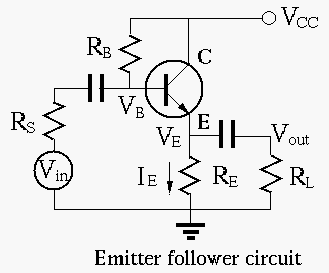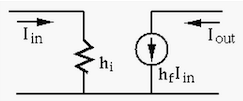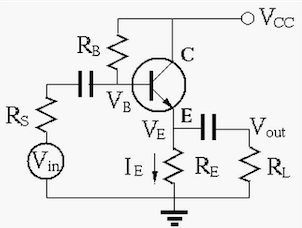Next: Multi-stage Amplification Up: ch4 Previous: AC equivalent circuits
The input and output of an emitter follower are the base and the emitter, respectively, and the collector is at AC zero. The circuit is therefore a common-collector circuit (for AC).

The negative feedback effect due to 
 |
(110) |
 |
(111) |
 we get:
we get:
 |
(112) |
 |
(113) |
 |
(114) |
Example 1




 |
 |
 |
|
 |
 |
 |
|
 |
 |
 |
|
 |
(115) |
Example 2
In the same circuit, find 


 |
(116) |
 we get
we get
 .
We can further verify this result:
.
We can further verify this result:
 |
(117) |
 |
(118) |
AC small-signal equivalent circuit
Based on small signal model of the transistor:

we find the AC equivalent circit of the emitter follower:


and we can further find the three system parameters: voltage gain, input resistance, and output resistance, as shown below.
As 


 |
(119) |
 |
(120) |
 .
.
We note that the voltage gain 

The input resistance is the parallel combination of 




![$\displaystyle v_b=i_b r_{be}+v_{out}=i_b\, [ r_{be}+(\beta+1)(R_E\vert\vert R_L) ]$](img482.svg) |
(121) |
 |
(122) |
 |
(123) |
 , we see that the
emitter follower has much higher input resistance.
, we see that the
emitter follower has much higher input resistance.
The output resistance is the parallel combination of 




 (
(
 ):
):
Due to the unity gain of the voltage gain follower,


 (
( ):
):
 |
(124) |
 |
(125) |
 |
(126) |
 , we see that the emitter follower has much
lower output resistance.
, we see that the emitter follower has much
lower output resistance.
Conclusion:
The emitter follower is a circuit with strong negative feedback,
i.e., the full output


 .
.
 (assuming
open-circuit with
(assuming
open-circuit with
 ).
).
 (assuming ideal source with
(assuming ideal source with  ).
).
 and
and
 , we have
, we have
 and
and
 . The emitter follower acts as an impedance
transformer with a ratio of
. The emitter follower acts as an impedance
transformer with a ratio of  .
.
Although the emitter follower circuit does not amplify the signal
voltage, it drastically improves the input and output resistances,
when compared with the common-emitter circuit with


Due to its high input resistance 


Example
For the emiter follower in the example above, the input resistance
is approximately

